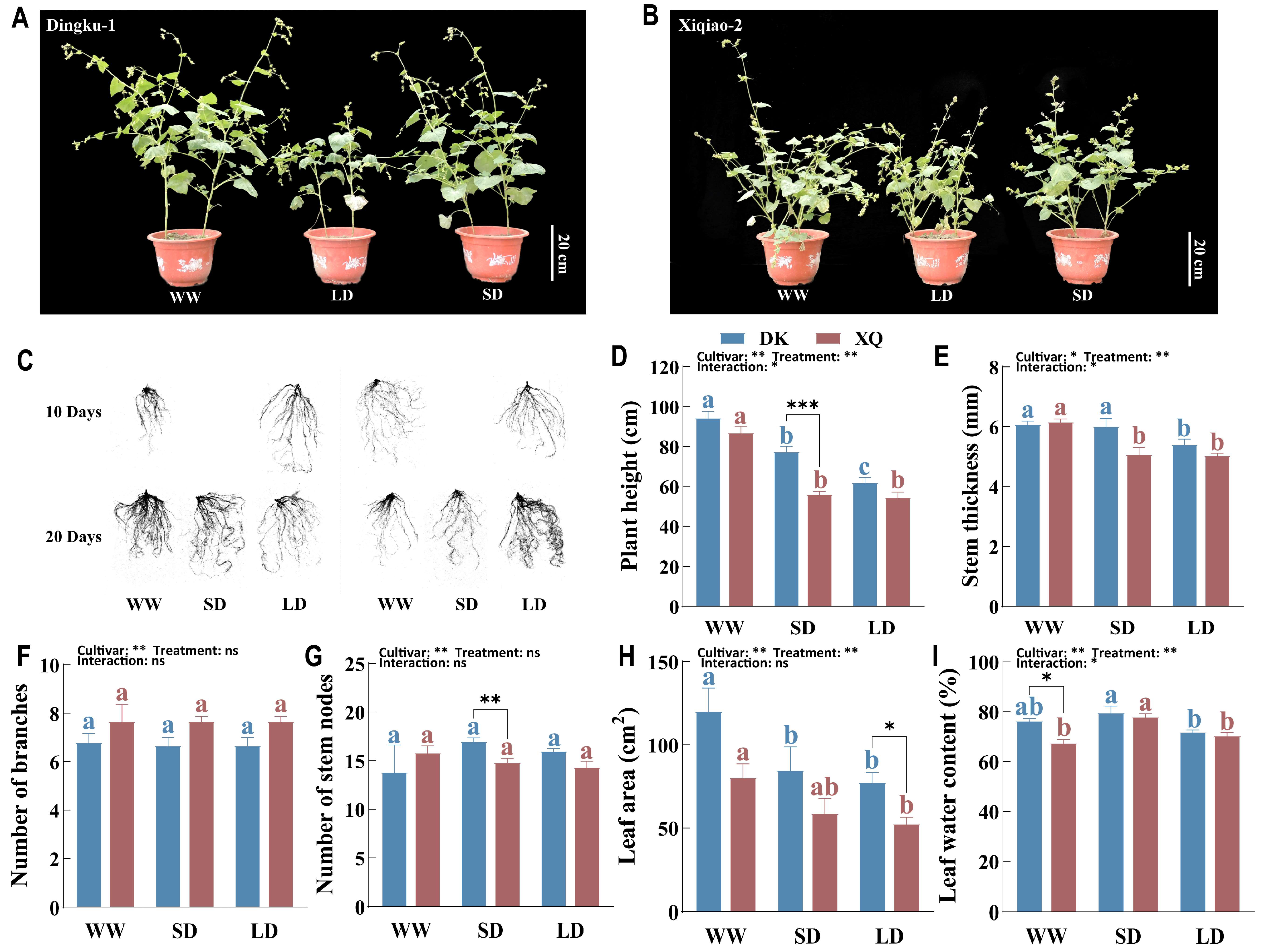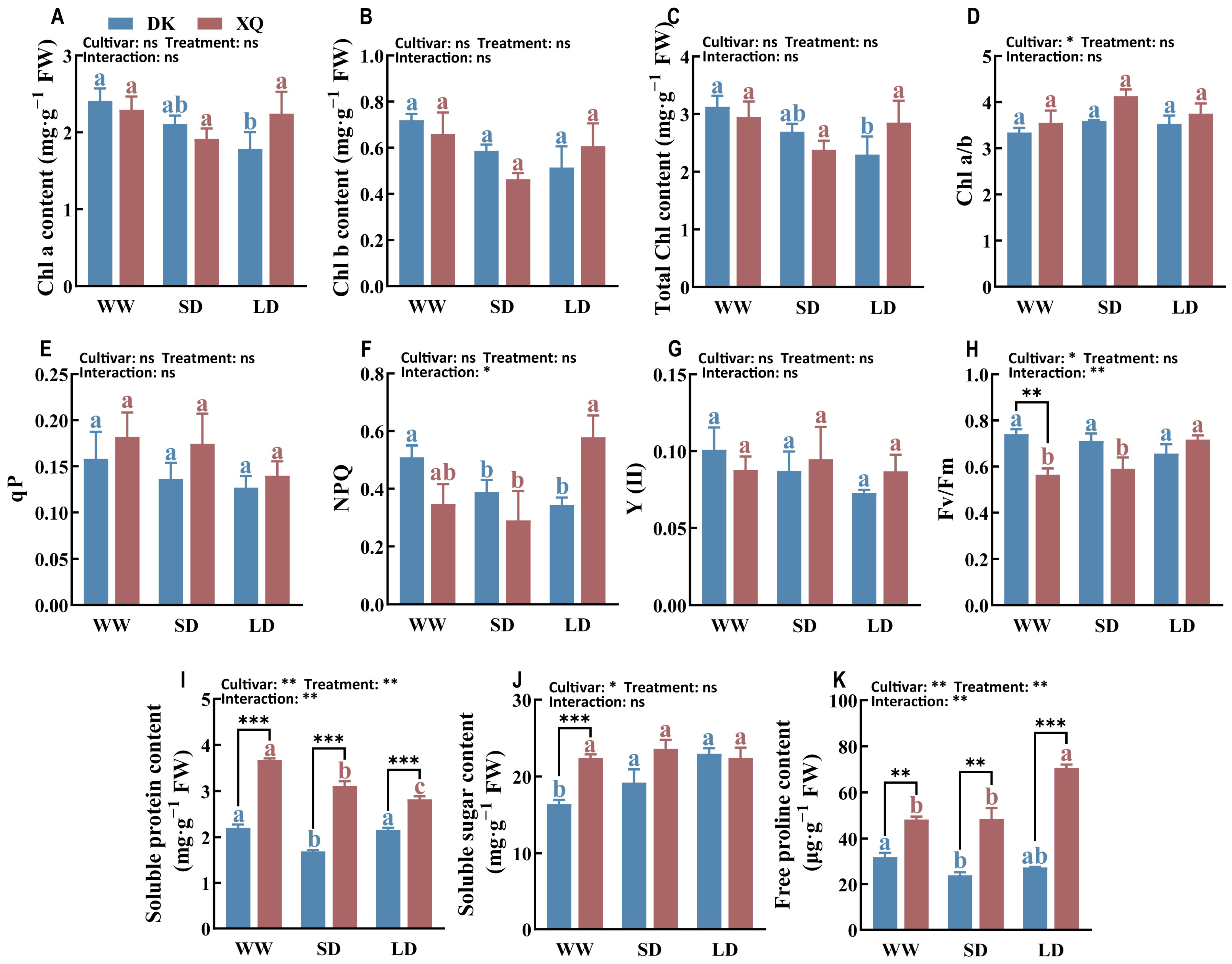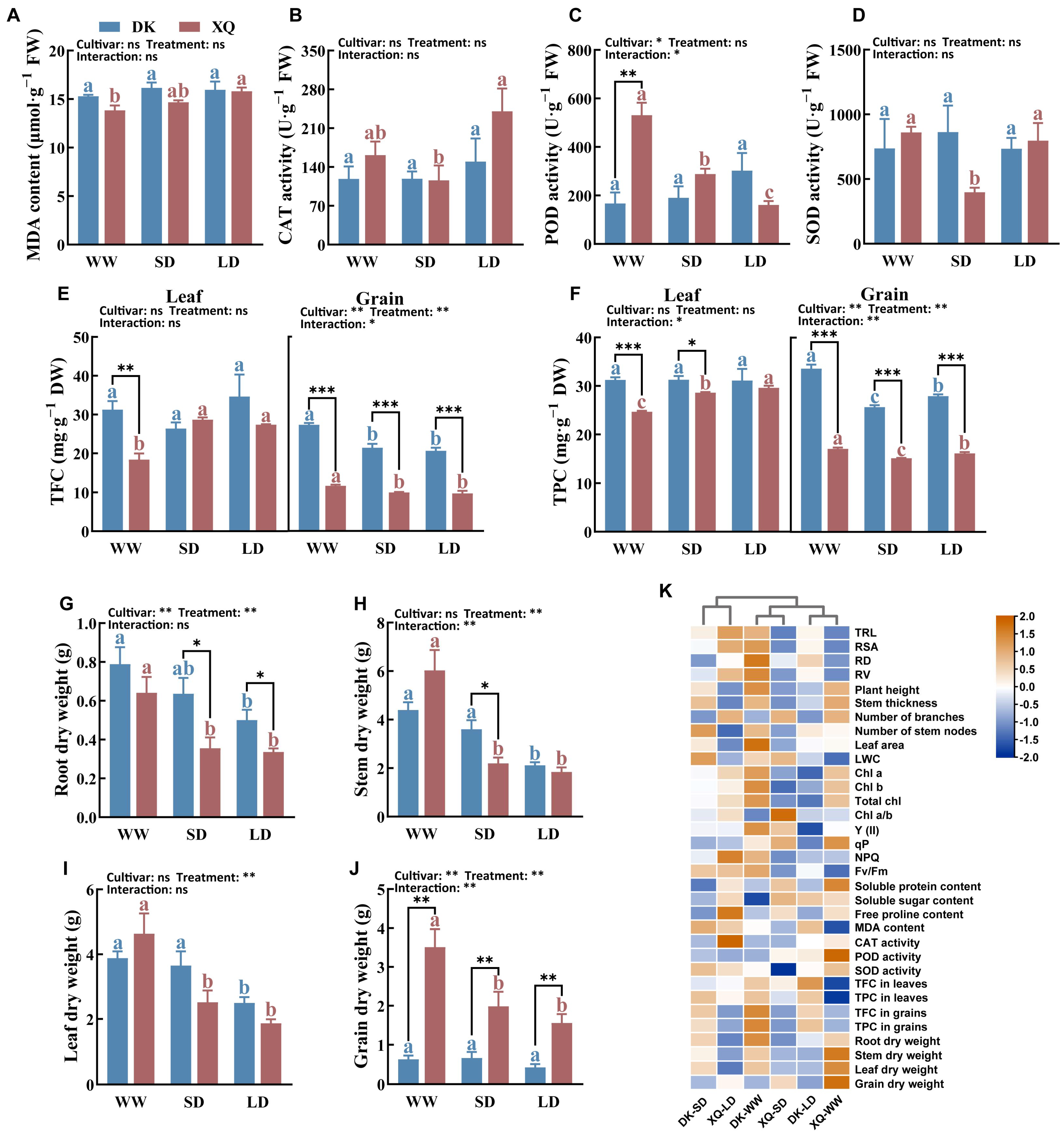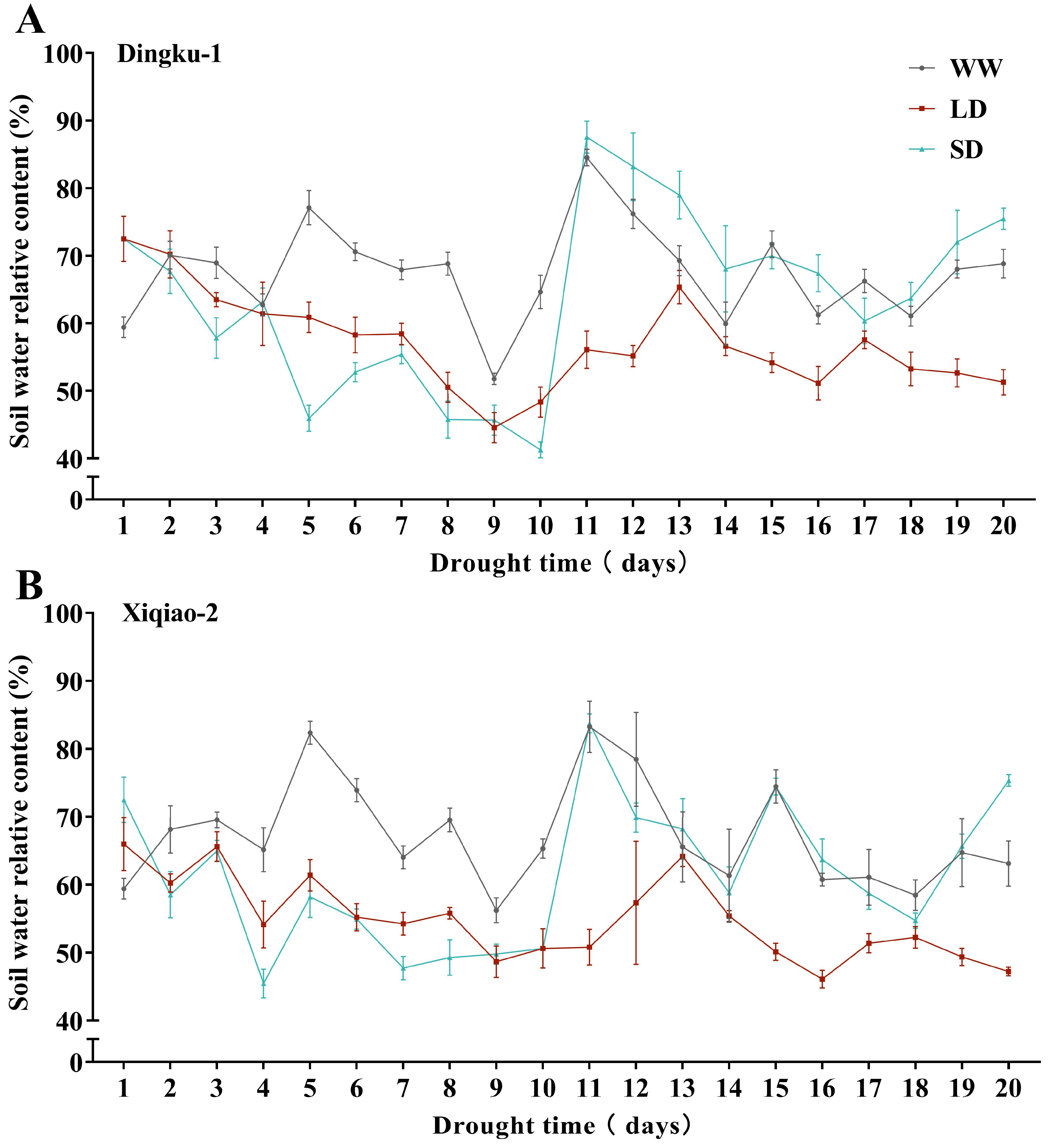Morphological, Physiological, and Photosynthetic Differences of Tartary Buckwheat Induced by Post-Anthesis Drought
Abstract
1. Introduction
2. Results
2.1. Plant Morphological Traits
2.2. Chlorophyll Content and Chlorophyll Fluorescence Parameters
2.3. Osmotic Regulation Response
2.4. Antioxidant Activity
2.5. Biomass Accumulation
3. Discussion
3.1. Effect of Post-Anthesis Drought on Growth Morphology of Tartary Buckwheat
3.2. Effects of Post-Anthesis Drought on Photosynthesis of Tartary Buckwheat
3.3. Physiological Response of Tartary Buckwheat to Post-Anthesis Drought
3.4. Effects of Drought Post-Anthesis on Biomass Accumulation of Tartary Buckwheat and Membership Function Analysis
4. Materials and Methods
4.1. Plant Material and Growing Conditions
4.2. Control of Drought Conditions
4.3. Plant Growth, Morphological Parameters, and Biomass
4.4. Chlorophyll Content and Chlorophyll Fluorescence
4.5. Soluble Sugar, Soluble Protein, and Free Proline
4.6. MDA and Antioxidant Enzyme Activity
4.7. Non-Enzymatic Antioxidants: Total Flavonoids, Total Polyphenols
4.8. Membership Function Analysis
4.9. Statistical Analyses
5. Conclusions
Author Contributions
Funding
Data Availability Statement
Conflicts of Interest
References
- Luthar, Z.; Golob, A.; Germ, M.; Vombergar, B.; Kreft, I. Tartary buckwheat in human nutrition. Plants 2021, 10, 700. [Google Scholar] [CrossRef] [PubMed]
- Li, C.; Kobayashi, K.; Yoshida, Y.; Ohsawa, R. Genetic analyses of agronomic traits in Tartary buckwheat (Fagopyrum tataricum (L.) Gaertn.). Breed. Sci. 2012, 62, 303–309. [Google Scholar] [CrossRef] [PubMed]
- Omena-Garcia, R.P.; Oliveira Martins, A.; Medeiros, D.B.; Vallarino, J.G.; Mendes Ribeiro, D.; Fernie, A.R.; Araújo, W.L.; Nunes-Nesi, A. Growth and metabolic adjustments in response to gibberellin deficiency in drought stressed tomato plants. Environ. Exp. Bot. 2019, 159, 95–107. [Google Scholar] [CrossRef]
- Charlton, A.J.; Donarski, J.A.; Harrison, M.; Jones, S.A.; Godward, J.; Oehlschlager, S.; Arques, J.L.; Ambrose, M.; Chinoy, C.; Mullineaux, P.M.; et al. Responses of the pea (Pisumsativum L.) leaf metabolome to drought stress assessed by nuclear magnetic resonance spectroscopy. Metabolomics 2008, 4, 312–327. [Google Scholar] [CrossRef]
- Brodersen, C.R.; Roddy, A.B.; Wason, J.W.; McElrone, A.J. Functional status of xylem through time. Annu. Rev. Plant Biol. 2019, 70, 407–433. [Google Scholar] [CrossRef] [PubMed]
- Wang, X.; Samo, N.; Li, L.; Wang, M.; Qadir, M.; Jiang, K.; Qin, J.; Rasul, F.; Yang, G.; Hu, Y. Root Distribution and its impacts on the drought tolerance capacity of hybrid rice in the sichuan basin area of china. Agronomy 2019, 9, 79. [Google Scholar] [CrossRef]
- Farooq, M.; Wahid, A.; Kobayashi, N.; Fujita, D.; Basra, S.M.A. Plant drought stress: Effects, mechanisms and management. Agron. Sustain. Dev. 2009, 29, 185–212. [Google Scholar] [CrossRef]
- Turner, N.C. Crop water deficits: A decade of progress. Adv. Agron. 1986, 39, 1–51. [Google Scholar] [CrossRef]
- Salehi-Lisar, S.Y.; Bakhshayeshan-Agdam, H. Drought stress in plants: Causes, consequences, and tolerance. In Drought Stress Tolerance in Plants, Vol 1: Physiology and Biochemistry; Springer: Cham, Switzerland, 2016; pp. 1–16. [Google Scholar] [CrossRef]
- Dhanda, S.S.; Sethi, G.S. Tolerance to drought stress among selected Indian wheat cultivars. J. Agric. Sci. 2002, 139, 319–326. [Google Scholar] [CrossRef]
- Budakli, E.; Celik, N.; Turk, M.; Bayram, G.; Tas, B. Effects of post-anthesis drought stress on the stem-reserve mobilization supporting grain filling of two-rowed barley cultivars at different levels of nitrogen. J. Biol. Sci. 2007, 7, 949–953. [Google Scholar] [CrossRef][Green Version]
- Blum, A. Improving wheat grain filling under stress by stem reserve mobilisation. Euphytica 1998, 100, 77–83. [Google Scholar] [CrossRef]
- Verbeke, S.; Padilla-Díaz, C.M.; Haesaert, G.; Steppe, K. Osmotic Adjustment in wheat (Triticum aestivum L.) during pre- and post-anthesis drought. Front. Plant Sci. 2022, 13, 775652. [Google Scholar] [CrossRef] [PubMed]
- Li, L.; Yan, X.; Li, J.; Tian, Y. Physiological and FtCHS gene expression responses to PEG-simulated drought and cadmium stresses in Tartary buckwheat seedlings. J. Plant Growth Regul. 2022, 41, 3518–3529. [Google Scholar] [CrossRef]
- Wan, Y.; Liang, Y.; Gong, X.; Ouyang, J.; Huang, J.; Wu, X.; Wu, Q.; Liu, C.; Ye, X.; Cao, X.; et al. Growth, ROS markers, antioxidant enzymes, osmotic regulators and metabolic changes in Tartary buckwheat subjected to short drought. Phyton-Int. J. Exp. Bot. 2023, 92, 35–54. [Google Scholar] [CrossRef]
- Xiang, D.; Wei, W.; Wan, Y.; Wu, X.; Ye, X.; Peng, L.; Zhong, L.; Wu, Q.; Zou, L.; Zhao, G.; et al. Polysaccharide elicitor from the endophyte bionectria sp. Fat6 improves growth of Tartary buckwheat under drought stress. Phyton-Int. J. Exp. Bot. 2021, 90, 461–473. [Google Scholar] [CrossRef]
- Bandurska, H. Drought stress responses: Coping strategy and resistance. Plants 2022, 11, 922. [Google Scholar] [CrossRef] [PubMed]
- Ghosh, D.; Xu, J. Abiotic stress responses in plant roots: A proteomics perspective. Front. Plant Sci. 2014, 5, 6. [Google Scholar] [CrossRef] [PubMed]
- Xiao, S.; Liu, L.; Zhang, Y.; Sun, H.; Zhang, K.; Bai, Z.; Dong, H.; Li, C. Fine root and root hair morphology of cotton under drought stress revealed with RhizoPot. J. Agron. Crop Sci. 2020, 206, 679–693. [Google Scholar] [CrossRef]
- Gontia-Mishra, I.; Sapre, S.; Sharma, A.; Tiwari, S. Amelioration of drought tolerance in wheat by the interaction of plant growth-promoting rhizobacteria. Plant Biol. 2016, 18, 992–1000. [Google Scholar] [CrossRef]
- Li, B.; Fan, R.; Sun, G.; Sun, T.; Fan, Y.; Bai, S.; Guo, S.; Huang, S.; Liu, J.; Zhang, H.; et al. Flavonoids improve drought tolerance of maize seedlings by regulating the homeostasis of reactive oxygen species. Plant Soil 2021, 461, 389–405. [Google Scholar] [CrossRef]
- Li, W.; Wang, Y.; Zhang, Y.; Wang, R.; Guo, Z.; Xie, Z. Impacts of drought stress on the morphology, physiology, and sugar content of Lanzhou lily (Lilium davidii var. unicolor). Acta Physiol. Plant. 2020, 42, 127. [Google Scholar] [CrossRef]
- Misra, V.; Solomon, S.; Mall, A.K.; Prajapati, C.P.; Hashem, A.; Abd_Allah, E.F.; Ansari, M.I. Morphological assessment of water stressed sugarcane: A comparison of waterlogged and drought affected crop. Saudi J. Biol. Sci. 2020, 27, 1228–1236. [Google Scholar] [CrossRef]
- Anjum, S.A.; Ashraf, U.; Tanveer, M.; Khan, I.; Hussain, S.; Zohaib, A.; Abbas, F.; Saleem, M.F.; Wang, L. Drought tolerance in three maize cultivars is related to differential osmolyte accumulation, antioxidant defense system, and oxidative damage. Front. Plant Sci. 2017, 8, 69. [Google Scholar] [CrossRef]
- Patmi, Y.S.; Pitoyo, A. Effect of drought stress on morphological, anatomical, and physiological characteristics of Cempo Ireng Cultivar Mutant Rice (Oryza sativa L.) strain 51 irradiated by gamma-ray. J. Phys. Conf. Ser. 2020, 1436, 012015. [Google Scholar] [CrossRef]
- Lau, S.-E.; Pua, T.-L.; Saidi, N.B.; Ong-Abdullah, J.; Lamasudin, D.U.; Tan, B.C. Combined proteomics and physiological analyses reveal drought and recovery response mechanisms in banana leaves. J. Plant Growth Regul. 2023, 42, 7624–7648. [Google Scholar] [CrossRef]
- Yang, X.; Lu, M.; Wang, Y.; Wang, Y.; Liu, Z.; Chen, S. Response mechanism of plants to drought stress. Horticulturae 2021, 7, 50. [Google Scholar] [CrossRef]
- Rucker, K.S.; Kvien, C.K.; Holbrook, C.C.; Hook, J.E. Identification of peanut genotypes with improved drought avoidance traits1. Peanut Sci. 1995, 22, 14–18. [Google Scholar] [CrossRef]
- Woo, N.S.; Badger, M.R.; Pogson, B.J. A rapid, non-invasive procedure for quantitative assessment of drought survival using chlorophyll fluorescence. Plant Methods 2008, 4, 27. [Google Scholar] [CrossRef] [PubMed]
- Din, J.; Khan, S.U.; Ali, I.; Gurmani, A.R. Physiological and agronomic response of canola varieties to drought stress. J. Anim. Plant Sci. 2011, 21, 78–82. [Google Scholar] [CrossRef]
- Brestic, M.; Zivcak, M.; Kunderlikova, K.; Sytar, O.; Shao, H.; Kalaji, H.M.; Allakhverdiev, S.I. Low PSI content limits the photoprotection of PSI and PSII in early growth stages of chlorophyll b-deficient wheat mutant lines. Photosynth. Res. 2015, 125, 151–166. [Google Scholar] [CrossRef]
- Calatayud, A.; Roca, D.; Martínez, P.F. Spatial-temporal variations in rose leaves under water stress conditions studied by chlorophyll fluorescence imaging. Plant Physiol. Biochem. 2006, 44, 564–573. [Google Scholar] [CrossRef] [PubMed]
- Sperdouli, I.; Moustakas, M. Differential response of photosystem II photochemistry in young and mature leaves of Arabidopsis thaliana to the onset of drought stress. Acta Physiol. Plant. 2012, 34, 1267–1276. [Google Scholar] [CrossRef]
- Giardi, M.T.; Cona, A.; Geiken, B.; Kučera, T.; Masojídek, J.; Mattoo, A.K. Long-term drought stress induces structural and functional reorganization of photosystem II. Planta 1996, 199, 118–125. [Google Scholar] [CrossRef]
- Hura, T.; Grzesiak, S.; Hura, K.; Thiemt, E.; Tokarz, K.; Wędzony, M. Physiological and biochemical tools useful in drought-tolerance detection in genotypes of winter triticale: Accumulation of ferulic acid correlates with drought tolerance. Ann. Bot. 2007, 100, 767–775. [Google Scholar] [CrossRef] [PubMed]
- Graßes, T.; Pesaresi, P.; Schiavon, F.; Varotto, C.; Salamini, F.; Jahns, P.; Leister, D. The role of ΔpH-dependent dissipation of excitation energy in protecting photosystem II against light-induced damage in Arabidopsis thaliana. Plant Physiol. Biochem. 2002, 40, 41–49. [Google Scholar] [CrossRef]
- Chen, Y.-E.; Liu, W.-J.; Su, Y.-Q.; Cui, J.-M.; Zhang, Z.-W.; Yuan, M.; Zhang, H.-Y.; Yuan, S. Different response of photosystem II to short and long-term drought stress in Arabidopsis thaliana. Physiol. Plant. 2016, 158, 225–235. [Google Scholar] [CrossRef] [PubMed]
- Osakabe, Y.; Osakabe, K.; Shinozaki, K.; Tran, L.-S.P. Response of plants to water stress. Front. Plant Sci. 2014, 5, 86. [Google Scholar] [CrossRef] [PubMed]
- Khaleghi, A.; Naderi, R.; Brunetti, C.; Maserti, B.E.; Salami, S.A.; Babalar, M. Morphological, physiochemical and antioxidant responses of Maclura pomifera to drought stress. Sci. Rep. 2019, 9, 19250. [Google Scholar] [CrossRef] [PubMed]
- Spieß, N.; Oufir, M.; Matušíková, I.; Stierschneider, M.; Kopecky, D.; Homolka, A.; Burg, K.; Fluch, S.; Hausman, J.-F.; Wilhelm, E. Ecophysiological and transcriptomic responses of oak (Quercus robur) to long-term drought exposure and rewatering. Environ. Exp. Bot. 2012, 77, 117–126. [Google Scholar] [CrossRef]
- Zhao, N.; Zhao, J.; Li, S.; Li, B.; Lv, J.; Gao, X.; Xu, X.; Lu, S. The response of endogenous ABA and soluble sugars of platycladus orientalis to drought and post-drought rehydration. Biology 2024, 13, 194. [Google Scholar] [CrossRef]
- Khanna-Chopra, R.; Selote, D.S. Acclimation to drought stress generates oxidative stress tolerance in drought-resistant than -susceptible wheat cultivar under field conditions. Environ. Exp. Bot. 2007, 60, 276–283. [Google Scholar] [CrossRef]
- ElSayed, A.I.; Rafudeen, M.S.; El-hamahmy, M.A.M.; Odero, D.C.; Hossain, M.S. Enhancing antioxidant systems by exogenous spermine and spermidine in wheat (Triticum aestivum) seedlings exposed to salt stress. Funct. Plant Biol. 2018, 45, 745–759. [Google Scholar] [CrossRef] [PubMed]
- Liu, X.; Zhang, T.; Song, Y.; Sun, S.; Wang, B.; Cui, S. Effects of severe drought stress on the physiology and biochemistry characteristics of Welsh onion (Allium fistulosum L. var. giganteum Makino) seedlings. Hortic. Sci. 2023, 50, 297–307. [Google Scholar] [CrossRef]
- Zhou, W.; Chen, Y.; Xu, H.; Liang, X.; Hu, Y.; Jin, C.; Lu, L.; Lin, X. Short-term nitrate limitation prior to harvest improves phenolic compound accumulation in hydroponic-cultivated lettuce (Lactuca sativa L.) without reducing shoot fresh weight. J. Agric. Food Chem. 2018, 66, 10353–10361. [Google Scholar] [CrossRef] [PubMed]
- Amir, S.B.; Rasheed, R.; Ashraf, M.A.; Hussain, I.; Iqbal, M. Hydrogen sulfide mediates defense response in safflower by regulating secondary metabolism, oxidative defense, and elemental uptake under drought. Physiol. Plant. 2021, 172, 795–808. [Google Scholar] [CrossRef] [PubMed]
- Tardieu, F. Any trait or trait-related allele can confer drought tolerance: Just design the right drought scenario. J. Exp. Bot. 2011, 63, 25–31. [Google Scholar] [CrossRef] [PubMed]
- Masoni, A.; Ercoli, L.; Mariotti, M.; Arduini, I. Post-anthesis accumulation and remobilization of dry matter, nitrogen and phosphorus in durum wheat as affected by soil type. Eur. J. Agron. 2007, 26, 179–186. [Google Scholar] [CrossRef]
- Shanmugam, S.; Kjaer, K.H.; Ottosen, C.-O.; Rosenqvist, E.; Kumari Sharma, D.; Wollenweber, B. The alleviating effect of elevated CO2 on heat stress susceptibility of two wheat (Riticum aestivum L.) cultivars. J. Agron. Crop Sci. 2013, 199, 340–350. [Google Scholar] [CrossRef]
- Barrs, H.; Weatherley, P. A re-examination of the relative turgidity technique for estimating water deficits in leaves. Aust. J. Biol. Sci. 1962, 15, 413–428. [Google Scholar] [CrossRef]
- Xiang, D.; Ma, C.; Song, Y.; Wu, Q.; Wu, X.; Sun, Y.; Zhao, G.; Wan, Y. Post-anthesis photosynthetic properties provide insights into yield potential of Tartary buckwheat cultivars. Agronomy 2019, 9, 149. [Google Scholar] [CrossRef]
- Arnon, D.I. Copper enzymes in isolated chloroplasts. polyphenoloxidase in Beta vulgaris. Plant Physiol. 1949, 24, 1–15. [Google Scholar] [CrossRef] [PubMed]
- Morris, D.L. Quantitative determination of carbohydrates with dreywood’s anthrone reagent. Science 1948, 107, 254–255. [Google Scholar] [CrossRef] [PubMed]
- Bradford, M.M. A rapid and sensitive method for the quantitation of microgram quantities of protein utilizing the principle of protein-dye binding. Anal. Biochem. 1976, 72, 248–254. [Google Scholar] [CrossRef] [PubMed]
- Bates, L.S.; Waldren, R.P.; Teare, I.D. Rapid determination of free proline for water-stress studies. Plant Soil 1973, 39, 205–207. [Google Scholar] [CrossRef]
- Aebi, H. [13] Catalase in vitro. In Methods in Enzymology; Academic Press: Cambridge, MA, USA, 1984; Volume 105, pp. 121–126. [Google Scholar] [CrossRef]
- Zhang, W.F.; Zhang, F.; Raziuddin, R.; Gong, H.J.; Yang, Z.M.; Lu, L.; Ye, Q.F.; Zhou, W.J. Effects of 5-aminolevulinic acid on oilseed rape seedling growth under herbicide toxicity stress. J. Plant Growth Regul. 2008, 27, 159–169. [Google Scholar] [CrossRef]
- Velikova, V.; Yordanov, I.; Edreva, A. Oxidative stress and some antioxidant systems in acid rain-treated bean plants: Protective role of exogenous polyamines. Plant Sci. 2000, 151, 59–66. [Google Scholar] [CrossRef]
- Zhanassova, K.; Kurmanbayeva, A.; Gadilgereyeva, B.; Yermukhambetova, R.; Iksat, N.; Amanbayeva, U.; Bekturova, A.; Tleukulova, Z.; Omarov, R.; Masalimov, Z. ROS status and antioxidant enzyme activities in response to combined temperature and drought stresses in barley. Acta Physiol. Plant. 2021, 43, 114. [Google Scholar] [CrossRef]
- Zhishen, J.; Mengcheng, T.; Jianming, W. The determination of flavonoid contents in mulberry and their scavenging effects on superoxide radicals. Food Chem. 1999, 64, 555–559. [Google Scholar] [CrossRef]
- Niroula, A.; Amgain, N.; Kc, R.; Adhikari, S.; Acharya, J. Pigments, ascorbic acid, total polyphenols and antioxidant capacities in deetiolated barley (Hordeum vulgare) and wheat (Triticum aestivum) microgreens. Food Chem. 2021, 354, 129491. [Google Scholar] [CrossRef]
- Li, X.; Ullah, S.; Chen, N.; Tong, X.; Yang, N.; Liu, J.; Guo, X.; Tang, Z. Phytotoxicity assessment of dandelion exposed to microplastics using membership function value and integrated biological response index. Environ. Pollut. 2023, 333, 121933. [Google Scholar] [CrossRef]




| Time | Treatment | Variety | TRL (cm) | RSA (cm2) | RV (cm3) | RD (mm) |
|---|---|---|---|---|---|---|
| 10 Days | WW | DK | 1460.25 ± 172.78 ab | 184.93 ± 26.66 ab | 0.4 ± 0.02 a | 1.88 ± 0.32 a |
| XQ | 1465.46 ± 156.11 ab | 158.37 ± 9.21 bc | 0.36 ± 0.02 a | 1.4 ± 0.11 ab | ||
| SD or LD | DK | 1922.41 ± 141.74 a | 214.72 ± 15.55 a | 0.36 ± 0.01 a | 1.91 ± 0.15 a | |
| XQ | 1017.69 ± 142.2 b | 108.93 ± 16.11 c | 0.34 ± 0.01 a | 0.93 ± 0.15 b | ||
| F value | Cultivars | 0.012 * | 0.002 ** | 0.117 | 0.002 ** | |
| Treatment | 0.964 | 0.588 | 0.147 | 0.291 | ||
| C × T | 0.011 * | 0.041 * | 0.476 | 0.227 | ||
| 20 Days | WW | DK | 2861.91 ± 121.3 a | 344.41 ± 34.3 a | 0.38 ± 0.02 a | 3.33 ± 0.53 a |
| XQ | 1325.36 ± 130.32 b | 128.01 ± 11.68 d | 0.31 ± 0 c | 0.99 ± 0.09 d | ||
| SD | DK | 2315.46 ± 190.89 a | 225.37 ± 21.47 c | 0.31 ± 0.01 c | 1.75 ± 0.2 cd | |
| XQ | 1281.99 ± 171.02 b | 132 ± 17.4 d | 0.33 ± 0.01 bc | 1.09 ± 0.16 d | ||
| LD | DK | 2264.59 ± 417.92 a | 241.72 ± 37.77 bc | 0.35 ± 0.02 ab | 2.06 ± 0.26 bc | |
| XQ | 3053.14 ± 338.35 a | 324.8 ± 42.12 ab | 0.34 ± 0.01 bc | 2.76 ± 0.42 ab | ||
| F value | Cultivar | 0.008 ** | 0.004 ** | 0.044 * | 0.004 ** | |
| Treatment | 0.007 ** | 0.005 ** | 0.095 | 0.007 ** | ||
| Interaction | 0.001 ** | 0.001 ** | 0.003 ** | 0.001 ** |
| Index | PC1 | PC2 | PC3 | Index | PC1 | PC2 | PC3 |
|---|---|---|---|---|---|---|---|
| TRL | 0.054 | −0.041 | 0.099 | Soluble protein content | −0.06 | 0.045 | 0.053 |
| RSA | 0.056 | −0.035 | 0.097 | Soluble sugar content | −0.067 | −0.034 | −0.014 |
| RD | 0.045 | −0.023 | 0.031 | Free proline content | −0.045 | −0.012 | 0.137 |
| RV | 0.058 | −0.028 | 0.093 | MDA content | 0.043 | −0.076 | −0.004 |
| Plant height | 0.041 | 0.087 | −0.009 | CAT activity | −0.021 | −0.027 | 0.144 |
| Stem thickness | 0.037 | 0.086 | −0.035 | POD activity | −0.045 | 0.066 | −0.043 |
| Number of branches | −0.062 | 0.016 | 0.084 | SOD activity | 0.031 | 0.038 | 0.054 |
| Number of stem nodes | 0.054 | 0.043 | −0.091 | TFC in leaves | 0.036 | −0.076 | −0.04 |
| Leaf area | 0.061 | 0.052 | −0.029 | TPC in leaves | 0.055 | −0.068 | −0.027 |
| LWC | 0.029 | −0.029 | −0.086 | TFC in grains | 0.07 | 0.01 | −0.054 |
| Chl a | 0.025 | 0.065 | 0.116 | TPC in grains | 0.07 | 0.004 | −0.045 |
| Chl b | 0.041 | 0.068 | 0.091 | Root dry weight | 0.052 | 0.072 | −0.031 |
| Total chl | 0.03 | 0.067 | 0.111 | Stem dry weight | 0.009 | 0.103 | −0.004 |
| Chl a/b | −0.058 | −0.043 | −0.018 | Leaf dry weight | 0.016 | 0.098 | −0.038 |
| Y (II) | 0.012 | 0.041 | 0.044 | Grain dry weight | −0.057 | 0.064 | 0.038 |
| qP | −0.038 | 0.072 | 0.005 | Variance contribution rate (%) | 40.325 | 29.141 | 17.29 |
| NPQ | 0.036 | −0.016 | 0.152 | Accumulated contribution rate (%) | 40.325 | 69.465 | 86.755 |
| Fv/Fm | 0.063 | −0.037 | 0.062 | Weight factors (%) | 46.4815 | 33.5900 | 19.9297 |
| Sample | X1 | X2 | X3 | μ1 | μ2 | μ3 | MFV | Rank |
|---|---|---|---|---|---|---|---|---|
| DK-WW | 1.484 | 0.568 | 0.375 | 1.000 | 0.564 | 0.469 | 0.748 | 1 |
| XQ-WW | −0.880 | 1.694 | 0.153 | 0.115 | 1.000 | 0.384 | 0.466 | 2 |
| DK-SD | 0.685 | −0.008 | −0.743 | 0.701 | 0.341 | 0.039 | 0.448 | 3 |
| XQ-LD | −0.317 | −0.889 | 1.756 | 0.326 | 0.001 | 1.000 | 0.351 | 4 |
| DK-LD | 0.214 | −0.891 | −0.846 | 0.525 | 0.000 | 0.000 | 0.244 | 5 |
| XQ-SD | −1.186 | −0.474 | −0.695 | 0.000 | 0.161 | 0.058 | 0.066 | 6 |
Disclaimer/Publisher’s Note: The statements, opinions and data contained in all publications are solely those of the individual author(s) and contributor(s) and not of MDPI and/or the editor(s). MDPI and/or the editor(s) disclaim responsibility for any injury to people or property resulting from any ideas, methods, instructions or products referred to in the content. |
© 2024 by the authors. Licensee MDPI, Basel, Switzerland. This article is an open access article distributed under the terms and conditions of the Creative Commons Attribution (CC BY) license (https://creativecommons.org/licenses/by/4.0/).
Share and Cite
Yuan, H.; Wang, Q.; Qi, A.; Li, S.; Hu, Y.; Hu, Z.; Guo, L.; Liang, C.; Li, W.; Liu, C.; et al. Morphological, Physiological, and Photosynthetic Differences of Tartary Buckwheat Induced by Post-Anthesis Drought. Plants 2024, 13, 2161. https://doi.org/10.3390/plants13152161
Yuan H, Wang Q, Qi A, Li S, Hu Y, Hu Z, Guo L, Liang C, Li W, Liu C, et al. Morphological, Physiological, and Photosynthetic Differences of Tartary Buckwheat Induced by Post-Anthesis Drought. Plants. 2024; 13(15):2161. https://doi.org/10.3390/plants13152161
Chicago/Turabian StyleYuan, Hang, Qiang Wang, Anyin Qi, Shuang Li, Yan Hu, Zhiming Hu, Laichun Guo, Chenggang Liang, Wurijimusi Li, Changying Liu, and et al. 2024. "Morphological, Physiological, and Photosynthetic Differences of Tartary Buckwheat Induced by Post-Anthesis Drought" Plants 13, no. 15: 2161. https://doi.org/10.3390/plants13152161
APA StyleYuan, H., Wang, Q., Qi, A., Li, S., Hu, Y., Hu, Z., Guo, L., Liang, C., Li, W., Liu, C., Sun, Y., Zou, L., Peng, L., Xiang, D., Liu, C., Huang, J., & Wan, Y. (2024). Morphological, Physiological, and Photosynthetic Differences of Tartary Buckwheat Induced by Post-Anthesis Drought. Plants, 13(15), 2161. https://doi.org/10.3390/plants13152161







